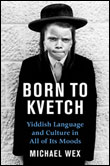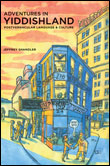
 In 1962, the American Jewish Congress released Invitation to Yiddish, a double-LP speak-along-with-the-record instructional course designed as a beginner’s introduction to Yiddish. The 16 lessons included “Waiting for the children,” “Why go to business?”, “On cooking and baking,” and one that was less of a lesson and more of a guilt trip: “You should know more about your people.”
In 1962, the American Jewish Congress released Invitation to Yiddish, a double-LP speak-along-with-the-record instructional course designed as a beginner’s introduction to Yiddish. The 16 lessons included “Waiting for the children,” “Why go to business?”, “On cooking and baking,” and one that was less of a lesson and more of a guilt trip: “You should know more about your people.”
Unlike most language-instruction records, though, Invitation to Yiddish wasn’t overly concerned with learning how to speak a language simply for the sake of speaking it. The album’s back cover listed the prime motivations: Yiddish is the language of your parents and grandparents, Yiddish was the language of hundreds of thousands of Jewish immigrants to the United States and Canada, Yiddish is needed to understand your own cultural background. Invitation to Yiddish may have nodded to Yiddish’s continuing, though faltering, presence in international life and politics after World War II, but above all, it stressed its role as a gateway to the past, a link to a fading cultural heritage.
This tension between Yiddish as a living, everyday language once spoken by 15 million people worldwide and now spoken by an estimated 3 million, and Yiddish as a symbolic language of heritage and identity — most commonly guffawed in punch lines or deployed as a nostalgia device — continues to define the way the language is written about and debated. Aaron Lansky, who founded the National Yiddish Book Center, in 1984, ended his rescue saga Outwitting History (newly out in paperback from Algonquin) with the hope that all his collecting was not just about preservation, but would be useful for a new generation of page turners who will “discover just how hip Yiddish really is.”
And that generation has, without a doubt, emerged. Yet for every new Yiddish course added to the curricula of universities, for every new cultural salon in New York or LA that explores Yiddish socialism, there are spoof books, such as 2004’s Yiddish with Dick and Jane, that remind us that the very idea of Yiddish as a language anyone would want to learn, let alone speak, is still grounds for a good laugh. Or take the Yiddish version of the magnetic-poetry series, in which the Yiddish language matters, but only in fragmentary form. It’s the words’ affect that counts most of all. Putting Yiddish words on your refrigerator door is not about speaking it, but about identifying with it, using it to say something about who you are.